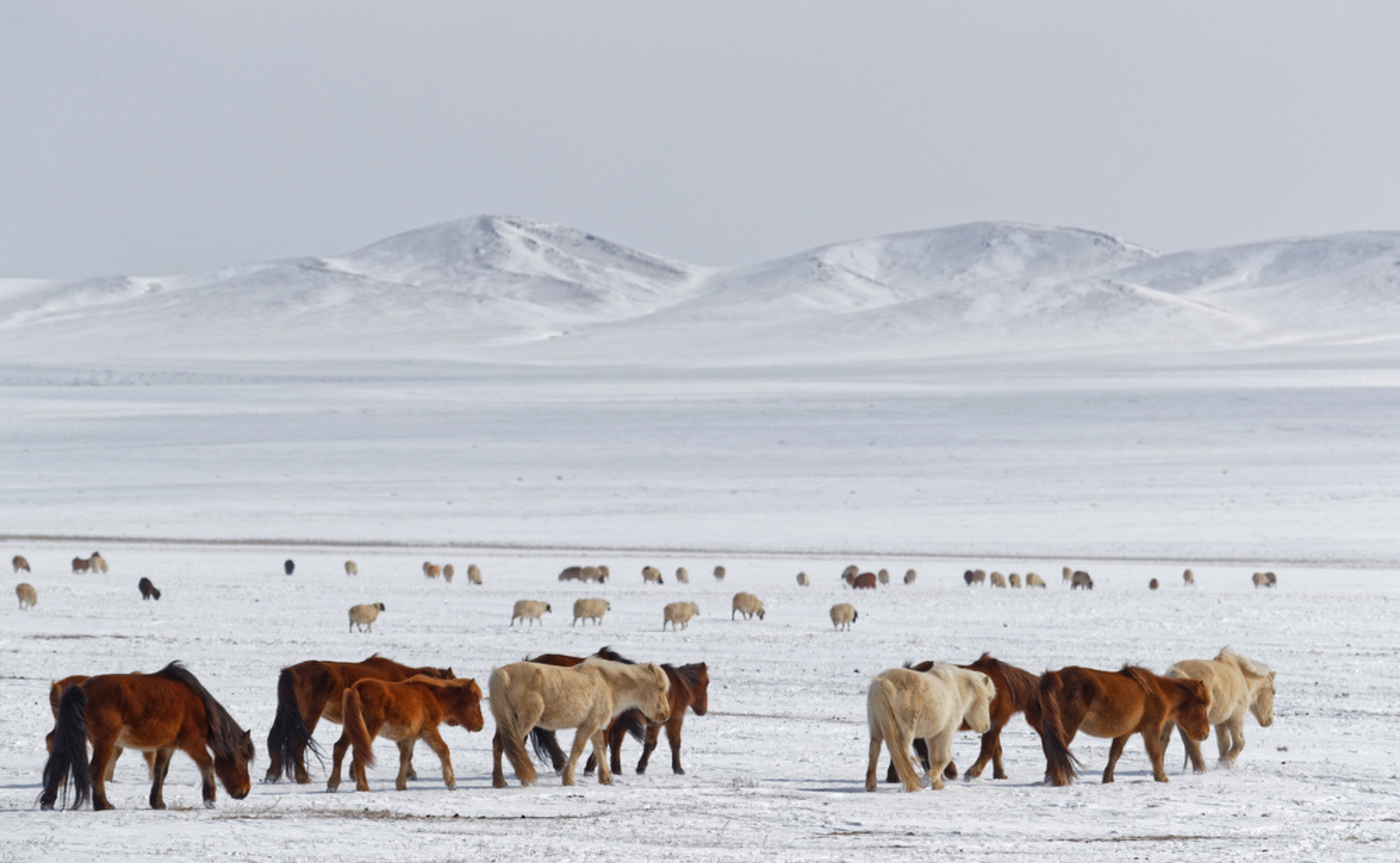
Imagine this: a herder’s entire livelihood—hundreds of sheep, goats, cattle, and horses—suddenly wiped out by an unstoppable force of nature. This is what dzud—a unique climate disaster marked by extreme cold, snowstorms, and unforgiving ice—can mean for Mongolia’s herding communities. These disasters have shaped Mongolian history and culture for centuries. For herders, they signal not just another harsh winter but a life-altering crisis that can lead to mass livestock deaths, poverty, and long-term economic instability.
Understanding the Threat of Dzud
Dzud events come in several forms, each posing a unique challenge. A “white dzud” involves deep, suffocating snow that buries pastures, starving livestock as they struggle to find food. A “black dzud,” in contrast, occurs after a dry summer, leaving little snow or water, which reduces forage availability and threatens herds with dehydration and starvation. The “iron dzud” is perhaps the most treacherous, covering grazing areas with an icy crust that animals cannot penetrate. A “combined dzud” brings a mix of these brutal conditions, creating an almost insurmountable barrier for herding families.
While dzud has always been a part of life in Mongolia, its frequency and intensity have escalated drastically in recent years, and climate change is at the heart of this shift. Since 2005, Mongolia has warmed by 1.59°C—a rate nearly 3 times the global average (Fetch 2021). This warming is changing Mongolia’s summers, making them hotter and drier, which dries up pastures and reduces the availability of forage. Without sufficient grazing and feed supplies, herders face a black dzud in winter.
However, climate change is not just warming summers—it is also intensifying winter snowfall. Warmer global temperatures allow the atmosphere to hold more moisture, leading to heavier snowfalls during winter storms (Fasullo and Trenberth 2008). This combination of dried-out summers followed by harshly snowy winters creates a vicious cycle where dzud conditions are more frequent and severe. Historically, dzud events happened roughly every 10 years. Today, however, they strike with alarming regularity, with six major dzud in just the past decade (Delgerjargal 2024).
Devastating Impacts on Mongolia’s Rural Economy
To grasp the scale of dzud’s impact, consider that around one-third of Mongolia’s population depends directly on livestock herding. Livestock rearing contributes about 80% of Mongolia’s agricultural output and roughly 10% of its gross domestic product (NSO 2022). For rural families, animals are not just economic assets; they are a way of life, a source of food, and often the only means of transportation. When dzud strikes, herders can lose anywhere from half to all of their livestock, a loss that devastates household income and plunges families into poverty. In 2023–2024 alone, livestock mortality spiked to 12.6%, with 8.1 million animals lost—a rate that recalls the worst dzud on record, which occurred in 2009-2010 and wiped out 20% of Mongolia’s livestock (National Statistical Office of Mongolia, 2024).
The economic ripple effect of such losses is profound. Dzud-induced livestock shortages drive up the prices of meat and dairy, essential foods in Mongolian diets. For herders who lose their animals, this means greater hardship, as they often must buy the food they once produced. Even for city dwellers, food insecurity becomes a pressing concern as the prices of meat and dairy soar. According to Sternberg (2010), dzud losses not only deepen poverty among rural families but also strain the food supply for the entire country.
The Cost of Dzud for Communities
When herders lose their animals, they lose their primary means of subsistence, and many are left with no choice but to leave their land. Driven by poverty, herders migrate to cities in search of work, adding to urban unemployment and poverty. For Mongolia, this shift weakens the social fabric of rural life. Moving to urban areas means herders must abandon the skills they have honed over generations and adapt to a completely different economic environment. This migration places additional strain on urban infrastructure and social services, leading to an increasing number of people living in poverty in urban centers (Algaa 2017). The depletion of rural communities also threatens Mongolia’s cultural heritage, as herding is an integral part of its national identity.
Beyond the economic and social toll, dzud brings significant environmental and public health risks. When millions of livestock die in a single winter, their carcasses are left scattered across the land. This creates a serious health hazard as decomposing carcasses can contaminate water sources, especially during spring thaws, when melted snow carries runoff into rivers and streams. This contamination raises the risk of disease outbreaks, posing a particular threat to herders and rural communities with limited access to healthcare (WHO 2024).
For children in herding communities, dzud has a hidden but severe impact on their education. During extreme winter conditions, many children are unable to attend school, either because roads are impassable or because their families prioritize survival over schooling. UNICEF (2024) estimates that more than 80,000 children from herding families faced disruptions to their education during recent dzud seasons. This impact is far-reaching, as missed schooling and limited access to educational resources can restrict these children’s future economic opportunities, perpetuating cycles of poverty in herding communities.
Dzud Management
Dzud management in Mongolia encompasses a comprehensive approach divided into mitigation, preparedness, response, and recovery phases. Mitigation and preparedness efforts focus on reducing risks and building resilience before dzud events occur. These measures include the development of policies and programs tailored to disaster risk reduction and community-based disaster risk management. Authorities provide weather forecasts, conduct community training sessions, and implement targeted projects, such as those addressing animal health, to strengthen herders’ ability to withstand dzud conditions.
The preparation stage involves proactive measures to ensure readiness for potential dzud impacts. The government generates resolutions on winter preparations, including stockpiling hay, fodder, and other essential supplies. Data collection and the deployment of dzud risk assessment teams further enhance readiness by identifying vulnerabilities and areas needing urgent attention.
During the response phase, immediate actions are taken to mitigate the impact of dzud on herders and livestock. Stocks of hay and fodder are distributed, along with vehicles for ambulances and rescue units. Public services, such as healthcare, are prioritized, and roads are cleared of blockages to ensure the smooth transport of relief goods. Domestic and international humanitarian aid is coordinated to address the immediate needs of affected populations effectively.
The recovery phase focuses on restoring livelihoods and enhancing resilience against future dzud. Cash grant projects are implemented to support affected herders, and efforts are made to clear livestock carcasses to prevent the spread of disease. Long-term recovery initiatives focus on building back better by strengthening infrastructure, improving resource management, and enhancing overall disaster preparedness for future events. This multi-faceted approach ensures a more sustainable response to Mongolia’s recurring dzud challenges.
Overcoming the Challenges of Dzud Response
Addressing the crisis of dzud is no small task, especially given Mongolia’s unique geographic challenges. With a low population density and vast, open steppes, herders often live miles away from basic services. Infrastructure is sparse, and roads are frequently blocked by snow, making it difficult to deliver essential supplies like food, hay, and medical aid. Although the Mongolian government occasionally uses helicopters to reach remote herding communities, this approach is costly and limited in scope (United Nations 2024). As a result, herders often wait weeks for assistance, intensifying the hardship of dzud.
Financially, herders are also vulnerable. To survive dzud, many herders are forced to take out loans or sell livestock at a loss, trapping them in a cycle of debt that can take years to recover from. The World Bank notes that without economic support systems like insurance or affordable loans, these herders face an uphill battle in regaining financial stability after a dzud event (Fernandez-Gimenez et al. 2012).
A Way Forward: Building Resilience Against Dzud
To help Mongolia’s herders cope with the increasing threat of dzud, a multifaceted approach is needed. Strengthening early warning systems and climate monitoring efforts will enable herders to prepare for dzud before conditions become critical. Education and outreach programs can assist herders in adopting more resilient grazing techniques and sustainable herding practices. Instead of focusing on the quantity of livestock, promoting quality-based intensive herding can ensure that animals are better prepared to survive harsh winters while also preventing overgrazing and pasture depletion (Fernandez-Gimenez et al. 2012).
Developing communal fodder reserves is another vital step in supporting herders during dzud events. Ensuring that hay and other feed are kept in accessible locations allows the government and local communities to create a crucial safety net for herders when they need it most. This strategy can significantly reduce livestock mortality and help preserve the livelihoods of herding families. In addition, providing financial assistance through low-interest loans and insurance options tailored to livestock-dependent households can alleviate economic pressures on herders and facilitate a quicker recovery after dzud strikes.
International partnerships also play a critical role, as organizations like UNICEF and the WHO offer essential support, ranging from educational resources for children to medical aid and emergency supplies. Expanding these collaborations can enhance relief efforts and provide herders with the resources they need to withstand and recover from dzud.
To ensure effective dzud management in the future, it is essential to enhance coordination among all stakeholders involved in this process. This begins with a clear definition and understanding of the roles and responsibilities of each stakeholder, fostering a better grasp of who is responsible for what. A well-articulated framework of responsibilities will encourage mutual collaboration and partnership among all parties, resulting in a more unified approach to dzud management. Furthermore, establishing accountability mechanisms is crucial to ensure that each stakeholder is accountable for their contributions and actions.
The rising frequency and severity of dzud incidents make it clear that adaptive strategies are urgently needed to help herders deal with climate change. By implementing effective early warning systems, promoting resilient herding practices, and seeking international support focused on building resilience and providing targeted assistance, Mongolia can effectively confront the challenges posed by dzud and secure a sustainable future for its herding population.
References
Algaa, S. 2017. Relationship Between Rural to Urban Migration and Dzud Disaster Impact. Mongolian Journal of Population 27: 78–82.
Delgerjargal, Z. 2024. In Mongolia, a Killer Winter Is Ravaging Herds and a Way of Life. Yale Environment 360.
Fasullo, J. T., and K. E. Trenberth. 2008. The Annual Cycle of the Energy Budget. Part II: Meridional Structures and Poleward Transports. Journal of Climate 21(10): 2313.
Fernandez-Gimenez, M. E., B. Batjav, and B. Baival. 2012. Lessons from the Dzud: Adaptation and Resilience in Mongolian Pastoral Social‐Ecological Systems. World Bank.
Fetch, S. 2021. State of the Planet. Columbia Climate School.
National Statistics Office of Mongolia (NSO). 2022. Statistics.
Sternberg, T. 2010. Unraveling Mongolia’s Extreme Winter Disaster of 2010. Nomadic Peoples 14(1): 72–86.
UNICEF. 2024. DZUD Humanitarian Situation Report. UNICEF Mongolia Office.
United Nations. 2024. 2024 Dzud Early Action and Response Plan Mongolia. United Nations Mongolia.
World Health Organization (WHO). 2024. Dzud Emergency in Mongolia Moves to Risk of Floods and Environmental Contamination.






